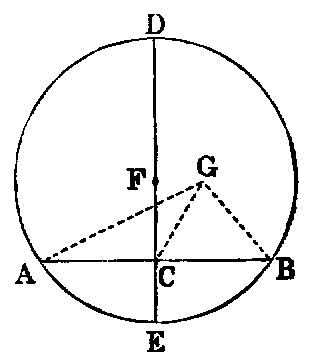Proposition 3.1

To find the centre of a given circle.
Let ABC be the given circle; thus it is required to find the centre of the circle ABC.
Let a straight line AB be drawn
through it at random, and let it be bisected at the point D; from D let DC be drawn at right angles to AB and let it be drawn through to E; let CE be bisected at F;
I say that F is the centre of the circle ABC.
For suppose it is not, but, if possible, let G be the centre, and let GA, GD, GB be joined.
Then, since AD is equal to DB, and DG is common, the two sides AD, DG are equal to the two sides BD, DG respectively; and the base GA is equal to the base GB, for they are
radii; therefore the angle ADG is equal to the angle GDB. [I. 8]
But, when a straight line set up on a straight line makes the adjacent angles equal to one another, each of the equal angles is right; [I. Def. 10]
therefore the angle GDB is right.
But the angle FDB is also right; therefore the angle FDB is equal to the angle GDB, the greater to the less: which is impossible. Therefore G is not the centre of the circle ABC.
Similarly we can prove that neither is any other point except F. Therefore the point F is the centre of the circle ABC.
From this it is manifest that, if in a circle a straight line cut a straight line into two equal parts and at
right angles, the centre of the circle is on the cutting straight line. Q. E. F.
